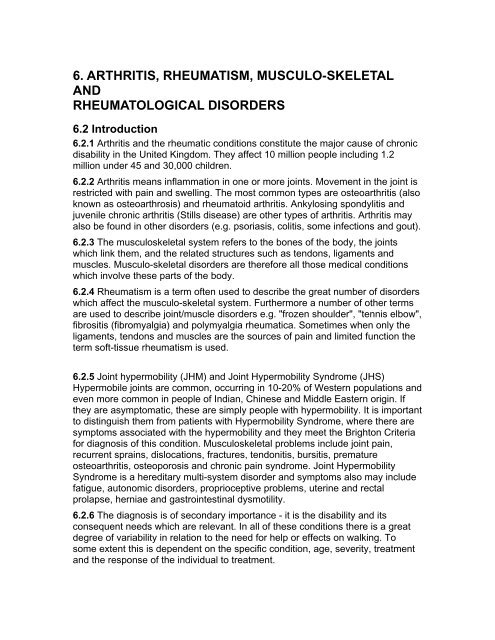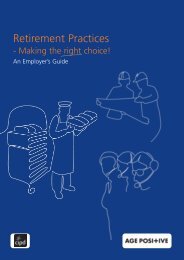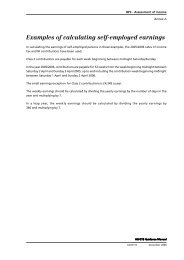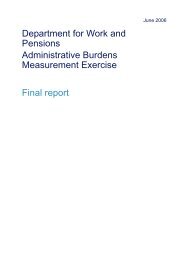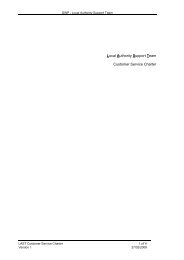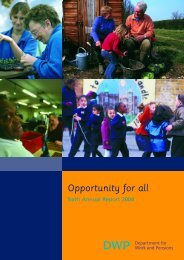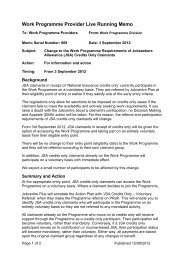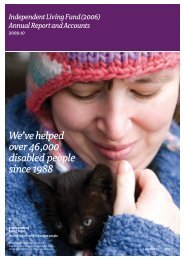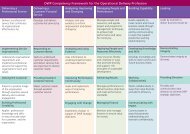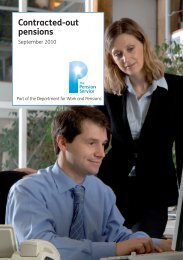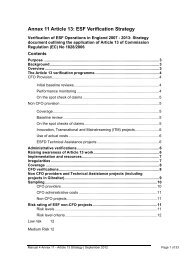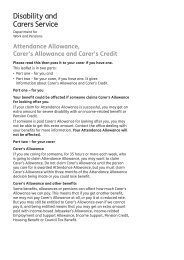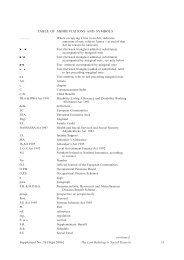Arthritis, rheumatism, musculo-skeletal and rheumatological disorders
Arthritis, rheumatism, musculo-skeletal and rheumatological disorders
Arthritis, rheumatism, musculo-skeletal and rheumatological disorders
You also want an ePaper? Increase the reach of your titles
YUMPU automatically turns print PDFs into web optimized ePapers that Google loves.
6. ARTHRITIS, RHEUMATISM, MUSCULO-SKELETAL<br />
AND<br />
RHEUMATOLOGICAL DISORDERS<br />
6.2 Introduction<br />
6.2.1 <strong>Arthritis</strong> <strong>and</strong> the rheumatic conditions constitute the major cause of chronic<br />
disability in the United Kingdom. They affect 10 million people including 1.2<br />
million under 45 <strong>and</strong> 30,000 children.<br />
6.2.2 <strong>Arthritis</strong> means inflammation in one or more joints. Movement in the joint is<br />
restricted with pain <strong>and</strong> swelling. The most common types are osteoarthritis (also<br />
known as osteoarthrosis) <strong>and</strong> rheumatoid arthritis. Ankylosing spondylitis <strong>and</strong><br />
juvenile chronic arthritis (Stills disease) are other types of arthritis. <strong>Arthritis</strong> may<br />
also be found in other <strong>disorders</strong> (e.g. psoriasis, colitis, some infections <strong>and</strong> gout).<br />
6.2.3 The <strong>musculo</strong><strong>skeletal</strong> system refers to the bones of the body, the joints<br />
which link them, <strong>and</strong> the related structures such as tendons, ligaments <strong>and</strong><br />
muscles. Musculo-<strong>skeletal</strong> <strong>disorders</strong> are therefore all those medical conditions<br />
which involve these parts of the body.<br />
6.2.4 Rheumatism is a term often used to describe the great number of <strong>disorders</strong><br />
which affect the <strong>musculo</strong>-<strong>skeletal</strong> system. Furthermore a number of other terms<br />
are used to describe joint/muscle <strong>disorders</strong> e.g. "frozen shoulder", "tennis elbow",<br />
fibrositis (fibromyalgia) <strong>and</strong> polymyalgia rheumatica. Sometimes when only the<br />
ligaments, tendons <strong>and</strong> muscles are the sources of pain <strong>and</strong> limited function the<br />
term soft-tissue <strong>rheumatism</strong> is used.<br />
6.2.5 Joint hypermobility (JHM) <strong>and</strong> Joint Hypermobility Syndrome (JHS)<br />
Hypermobile joints are common, occurring in 10-20% of Western populations <strong>and</strong><br />
even more common in people of Indian, Chinese <strong>and</strong> Middle Eastern origin. If<br />
they are asymptomatic, these are simply people with hypermobility. It is important<br />
to distinguish them from patients with Hypermobility Syndrome, where there are<br />
symptoms associated with the hypermobility <strong>and</strong> they meet the Brighton Criteria<br />
for diagnosis of this condition. Musculo<strong>skeletal</strong> problems include joint pain,<br />
recurrent sprains, dislocations, fractures, tendonitis, bursitis, premature<br />
osteoarthritis, osteoporosis <strong>and</strong> chronic pain syndrome. Joint Hypermobility<br />
Syndrome is a hereditary multi-system disorder <strong>and</strong> symptoms also may include<br />
fatigue, autonomic <strong>disorders</strong>, proprioceptive problems, uterine <strong>and</strong> rectal<br />
prolapse, herniae <strong>and</strong> gastrointestinal dysmotility.<br />
6.2.6 The diagnosis is of secondary importance - it is the disability <strong>and</strong> its<br />
consequent needs which are relevant. In all of these conditions there is a great<br />
degree of variability in relation to the need for help or effects on walking. To<br />
some extent this is dependent on the specific condition, age, severity, treatment<br />
<strong>and</strong> the response of the individual to treatment.
6.2.7 It is highly unlikely that the joints of people past middle age will be as<br />
supple, strong <strong>and</strong> resilient as those of the younger person. X rays of the joints of<br />
people past middle age (<strong>and</strong> sometimes in even younger people) may show<br />
abnormalities of the lining cartilage <strong>and</strong> the bones that make up the joints (e.g.<br />
thinning of the cartilage, "wear <strong>and</strong> tear", bony outgrowths, etc), but these<br />
radiological (i.e. X ray) findings may be present in very many people who do not<br />
have any problems in those joints. An X-ray report of joints which describes<br />
"arthritic changes" does not necessarily mean that the person with such changes<br />
has any significant pain or problem with that joint.<br />
6.3 Osteoarthritis (Osteo-Arthrosis, Degenerative Joint Disease)<br />
6.3.1 This disease of joints is not usually inflammatory but is characterized by<br />
wear <strong>and</strong> tear of the joints <strong>and</strong> is generally age related. It is the commonest type<br />
of arthritis. Joints which are particularly prone to develop osteoarthritis are the<br />
hip, knee, h<strong>and</strong>s <strong>and</strong> spine. Past or continuing trauma (ie injury) to the joints can<br />
accelerate the onset of osteoarthritis<br />
6.3.2 In the great majority of persons with osteoarthritis the disease is mild (with<br />
minimal or no needs) <strong>and</strong> principally affects one particular joint, which is the main<br />
source of pain <strong>and</strong> discomfort, such as the knee or hip, with minor or no<br />
involvement of other joints. The condition may have come to light during x-ray<br />
examination, even before the symptoms were noticed. See para 6.2.7 above. In<br />
other people, however, the disease is more severe, causing deformity <strong>and</strong><br />
extreme pain in affected joints. The problems may be alleviated by surgery, to<br />
replace the diseased joint with an artificial one (prosthesis). Those most<br />
commonly replaced in this way are the hip <strong>and</strong> knee joints. This operation is most<br />
often successful in significantly relieving joint pain <strong>and</strong> restoring pain-free<br />
movement.<br />
6.3.3 In older people multiple joints are affected <strong>and</strong>, because of disuse of the<br />
joints due to pain, there may be muscle wasting. This can be a factor contributing<br />
to falls in the elderly See Chapter 4.<br />
6.3.4 Care Needs<br />
(i) In osteoarthritis, the need for help, <strong>and</strong> its frequency, will depend very much<br />
on the number <strong>and</strong> location of joints involved <strong>and</strong> the degree of deformity,<br />
which may be so severe that surgical intervention is necessary to correct it<br />
<strong>and</strong> to relieve pain.<br />
(ii) Loss or limitation of h<strong>and</strong> <strong>and</strong> arm function may lead to a need for help<br />
during the day. In the early stages of the condition manual dexterity may be<br />
impaired leading to difficulty in h<strong>and</strong>ling common utensils. It may also make<br />
simple household tasks difficult or dangerous depending upon the degree of<br />
loss of function <strong>and</strong> reduced manual dexterity, <strong>and</strong>, of course, whether one or<br />
both h<strong>and</strong>s/arms are involved.<br />
(iii) When hip <strong>and</strong>/or knee function is limited or restricted with reduction in the<br />
ranges of movement at these joints, there may be problems with bathing,
dressing <strong>and</strong> undressing the lower half of the body, going up <strong>and</strong> down stairs<br />
<strong>and</strong> rising from a chair <strong>and</strong> in walking. In the older person, help may be<br />
needed getting out of bed in the morning <strong>and</strong> back in at night.<br />
(iv) Even when suitable, readily available, equipment or technical aids resolve<br />
some difficulties, others may persist <strong>and</strong> will depend upon individual<br />
circumstances.<br />
6.3.5 Mobility Considerations<br />
(i) Loss of hip <strong>and</strong>/or knee functions, especially when these are associated<br />
with problems in the ankles <strong>and</strong> feet, may lead to substantial difficulties in<br />
walking <strong>and</strong> being able to get around both in the home <strong>and</strong> outdoors. When<br />
the knee is affected the joint may become unstable, increasing the risk of falls,<br />
particularly in elderly people.<br />
(ii) In people with long-st<strong>and</strong>ing <strong>and</strong> advanced osteoarthritis of weight-bearing<br />
joints (such as the hip, knee, ankles <strong>and</strong> feet, etc) treatment with pain-relieving<br />
drugs (analgesics) or anti-inflammatory medications <strong>and</strong> physiotherapy, etc,<br />
may not significantly improve walking. Where joints have been replaced,<br />
however, walking itself <strong>and</strong> pain associated with walking is usually very much<br />
improved.<br />
6.3.6 Duration of Needs<br />
In people with the much more common milder forms of osteoarthritis care needs<br />
are minimal <strong>and</strong> walking is not usually limited to a significant extent. However,<br />
even in people with the milder forms of osteoarthritis affecting the weight-bearing<br />
joints there may be short periods lasting several weeks when there is increased<br />
pain <strong>and</strong> stiffness which may affect care needs <strong>and</strong> walking. The duration of<br />
established care needs <strong>and</strong> walking difficulties may be reduced, or even<br />
eliminated, by successful replacement with prosthetic joints.<br />
6.4 Inflammatory Joint Diseases<br />
6.4.1 Rheumatoid arthritis is a chronic inflammatory disease involving many<br />
joints simultaneously (polyarthritis), <strong>and</strong> most commonly involving the small joints<br />
of the h<strong>and</strong>s <strong>and</strong> feet, in a symmetrical fashion (i.e.: both wrists, both ankles).<br />
The affected joints become painful, swollen, stiff <strong>and</strong> in some cases deformed.<br />
The effects of disability are generally more severe than in osteoarthritis. Its onset<br />
is most often in a younger age group than those affected by osteoarthritis - even<br />
in childhood - but it may start in the older person. Many complications (in adults<br />
<strong>and</strong> children) may be found in severe arthritis which involve various parts of the<br />
body, including the heart, small blood vessels, the lungs, kidneys, eyes <strong>and</strong><br />
spleen.<br />
6.4.2 In juvenile chronic arthritis (Still's disease), the disease tends to affect the<br />
larger joints <strong>and</strong> growth can be impaired. Prognosis (outcome) is more<br />
favourable than in rheumatoid arthritis. For the majority of children the disease<br />
will "burn out" by the age of 16 or 18. Response to surgery such as hip or knee<br />
replacement is usually successful.
6.4.3 Other diseases which manifest principally as a chronic polyarthritis are<br />
psoriatic arthritis, reactive arthritis (Reiter's Syndrome), <strong>and</strong> ankylosing<br />
spondylitis.<br />
6.4.4 Psoriatic arthritis is similar to rheumatoid arthritis, the main difference being<br />
that it is usually associated with the skin condition psoriasis, <strong>and</strong> usually leads to<br />
less overall joint disablement. Rarely it can give rise to a particularly severe form<br />
of arthritis with severe joint destruction <strong>and</strong> resulting gross disablement when<br />
care needs will be at least as great as those described for severe rheumatoid<br />
arthritis.<br />
6.4.5 Reactive arthritis is a polyarthritis found in association with certain<br />
infections in other parts of the body. These are often in the gut or the urogenital<br />
system.<br />
6.4.6 Ankylosing spondylitis mainly involves the joints of the spine, is commoner<br />
in men, <strong>and</strong> often leads to a stiff <strong>and</strong> rigid spine. Symptoms may become worse<br />
with time, spreading from the low back to mid back <strong>and</strong> then the neck. Unless<br />
other joints than the spine are involved care needs <strong>and</strong> mobility considerations<br />
will be similar to those in people with the painful back See Chapter 7.<br />
6.4.7 Care Needs<br />
(i) In rheumatoid arthritis there is characteristically a prolonged period of joint<br />
stiffness in the morning on arising from bed, <strong>and</strong> after sitting in a chair for<br />
some time. During these periods of joint stiffness the affected person has to<br />
"limber-up" slowly <strong>and</strong> so may need help with dressing, rising from bed/chair,<br />
<strong>and</strong> washing. Bathing or showering in the morning may assist in the<br />
"limbering-up" process, <strong>and</strong> help would be required for this. The duration of<br />
morning stiffness often exceeds an hour in those with active inflammation of<br />
several joints. Even in remission, between the flare-ups, damaged joints may<br />
be painful <strong>and</strong> stiff in the mornings causing difficulties in taking medication,<br />
bathing <strong>and</strong> dressing.<br />
(ii) Damage to the joint structure may result in weakness of ligaments, tendons<br />
<strong>and</strong> surrounding muscles, causing the h<strong>and</strong>s <strong>and</strong> wrists to be weak with<br />
markedly impaired grip <strong>and</strong> loss of dexterity. Involvement of the finger joints<br />
may also seriously impair grip <strong>and</strong> manual dexterity, preventing the person<br />
from h<strong>and</strong>ling utensils, <strong>and</strong> making it difficult to cut food. In the early stages<br />
there may only be slight impairment of manual dexterity but help may be<br />
needed in the preparation of meals. If the shoulders <strong>and</strong> neck are affected<br />
this, too, may lead to difficulties with washing, dressing, cutting up food, <strong>and</strong><br />
eating. Putting on <strong>and</strong> taking off outdoor clothing, splints (when used) <strong>and</strong><br />
collars may also pose problems.<br />
(iii) Except in those with highly active disease, there should be little need for<br />
attention at night for such activities as toileting <strong>and</strong> turning in bed. During flareups,<br />
however, when splints <strong>and</strong> collars are used at night, removal of these to<br />
attend to toilet needs may be difficult. Help may also be required, in these<br />
circumstances, for taking pain relief medication.
(iv) Due to disuse atrophy (i.e. wasting of muscles) because of painful lower<br />
limb joints, falls can be a problem, generally in the older person.<br />
(v) In ankylosing spondylitis, because of back stiffness, assistance may be<br />
needed with lower garments when dressing <strong>and</strong> in getting in <strong>and</strong> out of the<br />
bath.<br />
6.4.8 Mobility Considerations<br />
(i) Walking may well be impaired in those with active inflammation of joints in<br />
lower limbs. When the feet are affected, this may cause severe pain on<br />
walking. If knees <strong>and</strong> hips are involved, st<strong>and</strong>ing <strong>and</strong> sitting can be difficult<br />
<strong>and</strong> painful, <strong>and</strong> walking more severely limited.<br />
6.4.9 Duration of Needs<br />
(i) The needs of persons with highly active joint inflammation may lessen<br />
dramatically when spontaneous remissions occur or in response to drugs.<br />
These drug treatments are associated with an improvement in the extent <strong>and</strong><br />
severity of arthritis. When this occurs it will be likely to do so within about one<br />
year's treatment. Patients are most responsive to treatment in the initial stages<br />
of rheumatoid arthritis (i.e. 2 to 5 years following onset).<br />
(ii) There will be older patients with a longst<strong>and</strong>ing history of rheumatoid<br />
arthritis in whom the disease may be "burnt-out", leaving many of the smaller<br />
joints of the h<strong>and</strong>s deformed with poor h<strong>and</strong> function or resulting in fixed<br />
deformities of lower limb joints with impairment of walking ability. In these<br />
people the needs will depend upon the overall disablement in the individual<br />
case but are unlikely to change throughout the remainder of the person's life.<br />
(iii) In the majority of people with rheumatoid arthritis, the disease smoulders<br />
on, involving further joints, <strong>and</strong> slowly increasing levels of disability <strong>and</strong><br />
associated needs.<br />
6.5 Osteoporosis<br />
6.5.1 Osteoporosis is the name given to a reduction or thinning in the total mass<br />
of bone present in the body. The precise mechanism causing this disease is<br />
unclear. It is found most frequently in women after the menopause, particularly in<br />
the older woman; <strong>and</strong> in people receiving long-term treatment with steroid<br />
compounds, e.g., for rheumatoid arthritis. Sometimes the condition is noted in<br />
younger women who have had their ovaries removed (oophorectomy).<br />
Inadequate physical activity promotes generalised osteoporosis <strong>and</strong> the condition<br />
also occurs in various gl<strong>and</strong>ular <strong>disorders</strong> <strong>and</strong> in cases of severe malnutrition<br />
<strong>and</strong> chronic renal (kidney) disease.<br />
6.5.2 The condition is of variable severity. In its mild form it may give rise to no<br />
symptoms <strong>and</strong> may be a chance X-ray finding. When the condition is more<br />
severe, pain may be a feature. This is usually due to fractures of the "brittle"<br />
bones, often occurring after only minor injury. Persistent backache may occur<br />
later on in the disease, due to progressive compression or collapse of several
vertebrae. The healing of fractures is not usually impaired <strong>and</strong>, with healing, the<br />
pain usually subsides. There is also a tendency for the condition to improve<br />
spontaneously, or with treatment. Suitable physical exercise is also helpful.<br />
6.5.3 Care Needs <strong>and</strong> Mobility Considerations<br />
(i) In all but its most severe forms osteoporosis of itself may be symptomless<br />
<strong>and</strong> give rise to no mobility problems or care needs. Even when there has<br />
been very considerable loss of bone mass it will be the pain <strong>and</strong> functional<br />
limitations associated with fractures or bone collapse (particularly in the back)<br />
that may give rise to care needs <strong>and</strong> mobility problems. In these severe cases<br />
(generally in elderly women) there may well be considerable care needs<br />
arising from disability associated with fractures. These commonly occur in the<br />
region of the wrist, back <strong>and</strong> hip joint. When fractures occur in the back or in<br />
the weight-bearing joints there may well be adverse effects on walking.<br />
Progressive collapse of the spinal vertebrae may result in a shortened, curved<br />
back causing chronic pain <strong>and</strong> walking problems.<br />
(ii) A person affected with this level of disease <strong>and</strong> its complications may also<br />
have difficulty with getting in <strong>and</strong> out of bed, rising from a chair, dressing <strong>and</strong><br />
undressing, preparing a main meal <strong>and</strong> attending to toilet needs. Under such<br />
circumstances, <strong>and</strong> particularly in elderly people, there may be care needs<br />
both by day <strong>and</strong> by night.<br />
(iii) When assessing the care needs which may arise, consideration should<br />
also be given to any other recorded disability(ies) which may give rise to<br />
mobility problems or care needs in their own right <strong>and</strong> which may interact with<br />
any needs arising from osteoporosis.<br />
(iv) Although the intellect is not affected in this disease, any tendency to fall<br />
may give rise to supervisory needs in elderly frail people, because of the<br />
increased risk of broken bones, <strong>and</strong> difficulty in rising after a fall..<br />
6.5.4 Duration of Needs<br />
Fractures heal at the normal rate, so that any resultant disability may not last<br />
more than a few weeks or months. This is particularly so in the younger person.<br />
In elderly people with osteoporosis who have sustained frequent fractures with<br />
progressive collapse of the spinal vertebrae, significant improvement in disability<br />
<strong>and</strong> care needs is unlikely during the remainder of the person's life.<br />
6.6 Joint Hypermobility Syndrome<br />
6.6.1 The Joint Hypermobility Syndrome (JHS) is a multi-system inherited<br />
connective tissue disorder thought to be caused by faulty fibrous tissue matrix<br />
proteins such as collagen. It is indistinguishable from Ehlers-Danlos Syndrome –<br />
Hypermobility type (previously known as Ehlers-Danlos type III).
6.6.2 Tissue laxity results in increased flexibility, an asset to some dancers,<br />
gymnasts, musicians <strong>and</strong> athletes. However, fragile tissues are prone to overuse<br />
injury, rupture <strong>and</strong> healing is poor <strong>and</strong> often delayed.<br />
Muscle <strong>and</strong> joint complications - joint pain, sprains, tendonitis, bursitis,<br />
recurrent dislocations, fractures, early arthritis <strong>and</strong> osteoporosis, chronic spinal<br />
disc problems with back <strong>and</strong> neck pain, chronic pain syndrome.<br />
Other complications - stretchy poor healing skin, uterine <strong>and</strong> rectal prolapse<br />
<strong>and</strong> stress incontinence, proprioceptive impairment leading to clumsiness <strong>and</strong><br />
falls, fatigue. Gastro-intestinal problems (abdominal pain, constipation,<br />
gastroparesis, reflux – can require multiple medications <strong>and</strong> even naso-gastric<br />
tube or PEG feeding). Autonomic Disorders occur in 78% of patients <strong>and</strong> include<br />
Vasodepressor Syncope <strong>and</strong> Postural Orthostatic Tachycardia Syndrome (PoTS)<br />
(increased pulse rate on st<strong>and</strong>ing or prolonged sitting can result in reduced blood<br />
supply to the brain <strong>and</strong> compensatory high adrenaline levels. Symptoms include<br />
fainting, dizziness, fatigue, poor concentration <strong>and</strong> memory problems,<br />
headaches, palpitations, tremor, sense of anxiety, nausea, sweats <strong>and</strong> visual<br />
problems. It produces functional impairment similar to that found in COPD <strong>and</strong><br />
heart failure).<br />
6.6.3 Joint Hypermobility Syndrome is under-diagnosed. In one survey, over 50%<br />
of patients waited over 10 years from onset of symptoms to receive a diagnosis.<br />
Many doctors (including some rheumatologists) are sceptical about its serious<br />
impact on patient’s lives.<br />
It can be difficult to match disability with patient appearance as they often look<br />
<strong>and</strong> move well .Assessors may incorrectly assume that because a joint has good<br />
range of movement <strong>and</strong> is not swollen, it cannot be painful.<br />
6.6.4 People with JHS often respond poorly to analgesics <strong>and</strong> local anaesthetics.<br />
With frequent <strong>and</strong> persistent painful episodes <strong>and</strong> poor pain control, they often<br />
develop widespread chronic pain with pain amplification <strong>and</strong> kinesiophobia<br />
(avoidance of movement to avoid pain). Deconditioning develops.<br />
Depression is common due to chronic uncontrolled pain, difficulty with tasks of<br />
daily living, diagnostic delay <strong>and</strong> failure to recognise symptom severity.<br />
6.6.5 Care Needs<br />
(i) People with severe forms of the Joint Hypermobility Syndrome may be in<br />
frequent or constant pain that is worsened by movements, especially those<br />
involving physical effort such as lifting. Joints may dislocate following minimal<br />
movement. When the tissues are damaged, physically dem<strong>and</strong>ing activities<br />
are also painful <strong>and</strong> give rise to care needs from another person. Periods of<br />
rest throughout the day may be required after only a modest amount of<br />
physical activity. Falls may occur so that certain activities such as bathing,
using stairs, etc may need to be supervised, particularly in elderly people with<br />
this syndrome.<br />
(ii) Main meal preparation, especially cutting up vegetables, opening jars,<br />
lifting pans <strong>and</strong> using taps may prove to be difficult .At times assistance may<br />
be required with toileting <strong>and</strong> personal hygiene.<br />
(iii) Special consideration may be required in the workplace. Chairs may need<br />
to be adapted to suit individual’s need e.g. high back, lumbar support, elevated<br />
seat. It may be necessary to adapt taps <strong>and</strong> door-h<strong>and</strong>les. Repetitive use of<br />
susceptible joints should be avoided. Special transport considerations may be<br />
necessary. Advice from an occupational therapist, physiotherapist or<br />
occupational health department may be helpful. Employees with autonomic<br />
complications may require a cool environment with the ability to take short<br />
regular breaks to eat <strong>and</strong> drink. Prolonged st<strong>and</strong>ing <strong>and</strong> sitting should be<br />
avoided. They may have special dietary requirements. Profound fatigue is a<br />
common problem <strong>and</strong> can impair stamina <strong>and</strong> concentration.<br />
6.6.6 Mobility Considerations<br />
(i) Because the connective tissues are lax <strong>and</strong> fragile they may be easily<br />
injured or dislocate. The combination of unstable, painful joints <strong>and</strong> balance<br />
problems may make walking difficult. People with severe forms of the<br />
syndrome require the use of walking aids (cane, crutches) or wheelchair.<br />
Patients can become bed-bound.<br />
6.6.7 Duration of Needs<br />
(i) Pain can result from sudden injuries to the soft tissues which take weeks or<br />
months to heal. Overenthusiastic physiotherapy from practitioners inexperienced<br />
with Joint Hypermobility Syndrome may exacerbate symptoms. Long delays in<br />
diagnosis means that many patients (for example 24 % of patient attending their<br />
first appointment at UCH Hypermobility Clinic) have established chronic pain<br />
syndrome <strong>and</strong> requiring a multi-disciplinary team approach to management.<br />
6.7 Further Evidence<br />
Because of the wide range of clinical manifestations <strong>and</strong> spectrum of disability<br />
<strong>and</strong> needs it may often be necessary to obtain further evidence, in the form of a<br />
GP or physiotherapist report or a report by an examining medical practitioner. A<br />
rheumatologist’s report may be particularly helpful.


